Connect With Us
Blog
Items filtered by date: August 2022
Foot Warts in Children
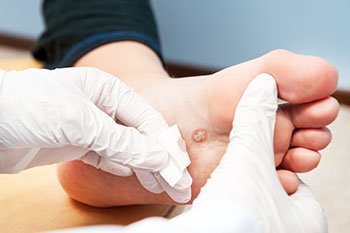
Plantar, or foot warts, are common in children. These warts are lumps that have hardened skin, are typically gray or brown in color, and have irregular surfaces. They are usually located on the heel or sole of the foot – areas that bear most body weight. Plantar warts are not always serious, but they can affect life quality. Foot warts in kids are caused by the human papillomavirus (HPV) and are aesthetically displeasing. Not all children with HPV will get plantar warts. They can occur from walking barefoot on floors containing the virus. Warm, wet areas, like public swimming pools, bathrooms, and changing rooms, are ideal breeding grounds for the virus. Oftentimes, there is a small wound on the foot, which provides an entrance for the foot wart. Plantar warts develop very slowly and may take up to a year to become visible. Symptoms vary depending on the location of the wart. They may hurt when walking and can get infected. If your child has a plantar wart, visit a podiatrist who can offer options for treatment.
Plantar warts can be very uncomfortable. If you need your feet checked, contact Arthur Segall, Jr., DPM from Segall Foot and Ankle. Our doctor will assist you with all of your foot and ankle needs.
About Plantar Warts
Plantar warts are the result of HPV, or human papillomavirus, getting into open wounds on the feet. They are mostly found on the heels or balls of the feet.
While plantar warts are generally harmless, those experiencing excessive pain or those suffering from diabetes or a compromised immune system require immediate medical care. Plantar warts are easily diagnosed, usually through scraping off a bit of rough skin or by getting a biopsy.
Symptoms
- Lesions on the bottom of your feet, usually rough and grainy
- Hard or thick callused spots
- Wart seeds, which are small clotted blood vessels that look like little black spots
- Pain, discomfort, or tenderness of your feet when walking or standing
Treatment
- Freezing
- Electric tool removal
- Laser Treatment
- Topical Creams (prescription only)
- Over-the-counter medications
To help prevent developing plantar warts, avoid walking barefoot over abrasive surfaces that can cause cuts or wounds for HPV to get into. Avoiding direct contact with other warts, as well as not picking or rubbing existing warts, can help prevent the further spread of plantar warts. However, if you think you have developed plantar warts, speak to your podiatrist. He or she can diagnose the warts on your feet and recommend the appropriate treatment options.
If you have any questions please feel free to contact our offices located in Plantation, FL Ft. Lauderdale, F . We offer the newest diagnostic and treatment technologies for all your foot and ankle needs.
Athlete’s Foot in Teens
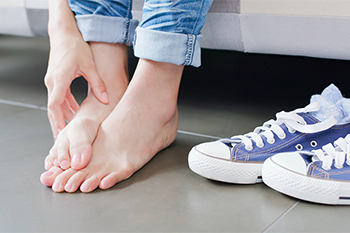
Athlete’s foot, also known as tinea pedis, is the most common fungal infection that affects the feet. It is common in older children, and it might occur in one or both feet. This fungus grows best in warm, moist areas of the skin and between the toes. Someone with this affliction will experience red, moist, scaly, and cracked skin that can be itchy and peeling between the toes. Sometimes they will find small blisters on the bottoms and sides of the feet. This might also be accompanied by an unpleasant odor and can come back repeatedly. Home treatment of athlete’s foot includes washing and drying the child’s feet daily, moisturizing them, using antifungal powders and lotions that can be purchased over-the-counter, wearing clean socks daily, wearing shoes that breathe, not sharing shoes or socks with others, rotating shoes between wearing them, and making sure to wear footwear in public spaces like community showers, gyms, or swimming pools. If the condition is not healing, an infection develops, the feet swell, there is pus or pain, consult with a podiatrist for a more effective treatment for your child’s athlete’s foot.
Making sure that your children maintain good foot health is very important as they grow. If you have any questions, contact Arthur Segall, Jr., DPM of Segall Foot and Ankle. Our doctor can provide the care you need to keep you pain-free and on your feet.
Keeping Children's Feet Healthy
Having healthy feet during childhood can help prevent medical problems later in life, namely in the back and legs. As children grow, their feet require different types of care. Here are some things to consider...
Although babies do not walk yet, it is still very important to take care of their feet.
Avoid putting tight shoes or socks on his or her feet.
Allow the baby to stretch and kick his or her feet to feel comfortable.
As a toddler, kids are now on the move and begin to develop differently. At this age, toddlers are getting a feel for walking, so don’t be alarmed if your toddler is unsteady or ‘walks funny’.
As your child gets older, it is important to teach them how to take care of their feet.
Show them proper hygiene to prevent infections such as fungus.
Be watchful for any pain or injury.
Have all injuries checked by a doctor as soon as possible.
Comfortable, protective shoes should always be worn, especially at play.
If you have any questions please feel free to contact our offices located in Plantation, FL Ft. Lauderdale, F . We offer the newest diagnostic and treatment technologies for all your foot and ankle needs.
What Is a Plantar Fibroma?
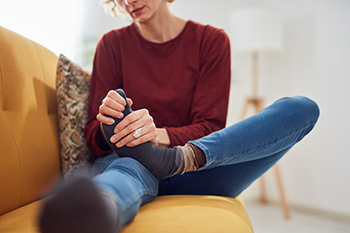
If you notice a bump on the arch of your foot, it may be a plantar fibroma. It is defined as a benign growth that develops in the plantar fascia, which is the band of tissue on the sole of the foot. Its function is to connect the toes to the heels, and contributes to stabilizing the arch. A plantar fibroma can gradually increase in size, and can be present on one or both feet. It may begin as a lesion, and can lead to plantar fibromatosis, which is also known as Ledderhose disease. The common symptoms that many patients experience can be painless bumps in the beginning stages on the arch of the foot, and may eventually become worse if left untreated. It may be uncomfortable to walk or stand for an extended period of time, and wearing shoes may cause friction. Research has indicated it may be unknown why a plantar fibroma may develop, despite possibly being connected to specific medical conditions. These include diabetes, liver disease, or epilepsy. There are several treatment options for this ailment, and it is strongly suggested that you schedule an appointment with a podiatrist who can help you with a plantar fibroma.
A plantar fibroma may disrupt your daily activities. If you have any concerns, contact Arthur Segall, Jr., DPM of Segall Foot and Ankle. Our doctor can provide the care you need to keep you pain-free and on your feet.
Plantar Fibroma
A plantar fibroma is a fibrous knot in the arch of the foot. It is embedded in the plantar fascia which is a band of tissue that extends from the heel to the toes along the bottom of the foot. There can be multiple plantar fibromas in the feet at the same time. There are no known causes for this condition. If you have a plantar fibroma, there will be a bump in the arch of your foot that cannot be missed. Any associated pain is most often due to a shoe rubbing against the nodule. Non-surgical options, such as steroid injections, physical therapy, and orthotics should be tried first. Surgery is a last resort and is the only thing that will remove a plantar fibroma entirely. Consult with a podiatrist for a proper diagnosis and to determine the treatment regimen that is right for you.
What Causes a Plantar Fibroma?
While there are no specific causes identified, a plantar fibroma can possibly come from genetic predisposition or the formation of scar tissue that forms from healing the tears in the plantar fascia.
What Are the Symptoms of a Plantar Fibroma?
There will be a noticeable lump in the arch of the foot that may or may not cause pain. If pain is felt, it is typically because a shoe is rubbing up against the lump or when walking or standing barefoot.
Treatment and Prevention
A plantar fibroma will not disappear without treatment, but it can get smaller and be a non-issue. If pain persists, a podiatrist examines the foot and when the arch of the foot is pressed, pain can be felt down to the toes. An MRI or biopsy might be performed to help diagnose or evaluate the plantar fibroma. The following non-surgical options are generally enough to reduce the size and pain of these nodules:
- Steroid injections
- Orthotics
- Physical therapy to help apply anti-inflammatory creams on the bump
Surgery is considered if the mass increases in size and the patient continues to feel pain after non-surgical methods are tried.
If you have any questions please feel free to contact our offices located in Plantation, FL Ft. Lauderdale, F . We offer the newest diagnostic tools and technology to treat your foot and ankle needs.
Do Your Child's Feet Hurt?
Dealing With a Hammertoe
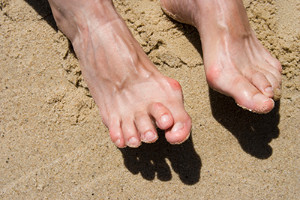
A hammertoe is when a toe is stuck in an upward bent position at the middle of a joint. The top of the toe is bent forward and looks like a hammer, hence its name. It is one of the most common deformities of the forefoot and can affect balance as well as cause pain and trouble with walking and other activities. Hammertoes can happen when the small muscles on the bottom of the feet (intrinsic muscles) are weaker than the larger muscles on the top of the foot (extrinsic muscles). Hammertoe can often be a result of other issues, such as having flat feet with longer metatarsals or middle foot bones, having a bunion, having a medical condition such as diabetes or inflammatory arthropathies that affect muscles, tendons, and nerves in the feet, and wearing shoes that are too narrow or tight, forcing the toes down into the tip of the shoe. Beyond pain, if you have a hammertoe, you may experience swelling or redness of the toe, callus formation on the parts of the toe that rub against the shoe, and changes in walking patterns. Treatment includes wearing properly fitted shoes with wide toe boxes, doing toe stretching and other exercises to build up the strength of the intrinsic muscles of the foot, wearing cushions, pads, or insoles, taping, and possibly surgery. Early intervention is more likely to work since the toe joint will be more apt to be flexible. If you feel you have a hammertoe, and particularly if it is causing you discomfort, talk with a podiatrist about treatment that might work best for you.
Hammertoes can be a painful condition to live with. For more information, contact Arthur Segall, Jr., DPM of Segall Foot and Ankle. Our doctor will answer any of your foot- and ankle-related questions.
Hammertoe
Hammertoe is a foot deformity that occurs due to an imbalance in the muscles, tendons, or ligaments that normally hold the toe straight. It can be caused by the type of shoes you wear, your foot structure, trauma, and certain disease processes.
Symptoms
- Painful and/or difficult toe movement
- Swelling
- Joint stiffness
- Calluses/Corns
- Physical deformity
Risk Factors
- Age – The risk of hammertoe increases with age
- Sex – Women are more likely to have hammertoe compared to men
- Toe Length – You are more likely to develop hammertoe if your second toe is longer than your big toe
- Certain Diseases – Arthritis and diabetes may make you more likely to develop hammertoe
Treatment
If you have hammertoe, you should change into a more comfortable shoe that provides enough room for your toes. Exercises such as picking up marbles may strengthen and stretch your toe muscles. Nevertheless, it is important to seek assistance from a podiatrist in order to determine the severity of your hammertoe and see which treatment option will work best for you.
If you have any questions, please feel free to contact our offices located in Plantation, FL Ft. Lauderdale, F . We offer the newest diagnostic and treatment technologies for all your foot care needs.
The Burning Foot Syndrome
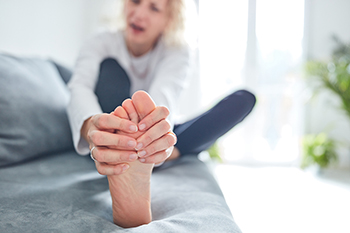
The rare foot condition that is known as Grierson-Gopalan syndrome is also referred to as burning feet syndrome. The symptoms of this ailment include a painful burning sensation on the bottom of the feet that may spread to the lower legs and top of the feet. There are several reasons why this condition may occur, including peripheral neuropathy, which can be common among diabetic patients. This is caused by nerve damage in the feet and may be a reason why burning feet syndrome arises. Morton’s neuroma is generally caused by wearing shoes that are too tight, causing a nerve between the toes to thicken. Additionally, some people undergo complex regional pain syndrome, which may happen after an injury has occurred or if surgery has been performed. It is a rare syndrome, and the burning pain may come from a nerve disorder. Immediate relief may be found when soaking the feet in cold water and elevating the feet to slow down the blood flow. If you have any symptoms of this disorder, it is strongly suggested that you confer with a podiatrist who can prescribe the necessary medications for you.
Some foot conditions may require additional professional care. If you have any concerns, contact Arthur Segall, Jr., DPM of Segall Foot and Ankle. Our doctor can provide the care you need to keep you pain-free and on your feet.
Rare Foot Conditions
The majority of foot conditions are common and can be treated by a podiatrist. Standard diagnostic procedures are generally used to identify specific conditions and treatment can be rendered. A podiatrist also treats rare foot conditions which can be difficult to diagnose and may need extra attention and care.
There are many rare foot conditions that can affect children. Some of these can include:
- Freiberg’s disease
- Kohler’s disease
- Maffucci syndrome
Freiberg’s disease - This can be seen as a deterioration and flattening of a metatarsal bone that exists in the ball of the foot. It typically affects pre-teen and teenage girls, but can affect anyone at any age. Symptoms that can accompany this can be swelling, stiffness, and the patient may limp.
Kohler’s disease - This often targets the bone in the arch of the foot and affects younger boys. It can lead to an interruption of the blood supply which ultimately can lead to bone deterioration. The patient may limp or experience tenderness, swelling, and redness.
Maffucci syndrome - This affects the long bones in a child’s foot leading to the development of abnormal bone lesions. They are benign growths and typically develop in early childhood and the bones may be susceptible to breaking.
A podiatrist can properly diagnose and treat all types of rare foot conditions. If your child is affected by any of these symptoms or conditions, please don’t hesitate to call our office so the correct treatment method can begin.
If you have any questions please feel free to contact our offices located in Plantation, FL Ft. Lauderdale, F . We offer the newest diagnostic tools and technology to treat your foot and ankle needs.

